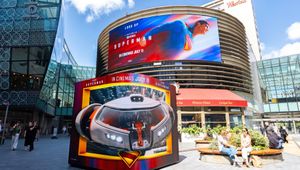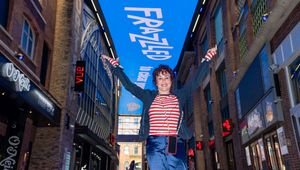
How Digital Out of Home’s Creative 3D Activations Drive Attention among Younger Audiences

It’s long been said that data is the new oil (source: Clive Humby, 2006), but attention is a much scarcer resource. Attention, how to achieve it and how to maintain it, is an increasingly complex challenge for brands, in what has become an ever more complex media landscape.
The consumer is exposed to numerous advertising messages throughout their daily lives, and the consequence of this is withdrawal and 'inertia' towards brands. This is evidenced by the PR firm Grayling in their most recent Brand Inertia Report, which found that 97% of consumers were showing at least one sign of inertia when considering which brands they chose to support.
Given that 75% of consumers felt that all brands in the same category were the same, it’s clear that greater distinctiveness is required by advertisers to achieve greater cut-through, particularly amongst city-dwelling audiences, in which the level of exposure to advertising is heaviest.
As Grayling make clear, it’s “clear and differentiated propositions, rooted in added value, that will win”.
This is the current landscape in which innovative, highly creative, and impactful, premium DOOH can thrive. Over the past 15 years, Ocean has pioneered The Art of Outdoor a distinctive, innovative and creative core value and proposition within the OOH medium.

Taking DOOH creativity to a new level, the roll out of Ocean’s 3D DeepScreen, has become a means for advertisers to cut-through the noise, generating wide earned media coverage and comment in the international press and amplification beyond the physical screen via social media shares.
Testing the effectiveness of 3D DeepScreen as a premium DOOH offer on audiences was an obvious next step to help advertisers and brands understand the value and see the opportunities that exist via this creative format.
Methodology
Ocean partnered with the research agency Opinium to test the effectiveness of DeepScreen 3D activations.
The study had three mains objectives:
- To compare the brand impact and creative effects of 3D DeepScreen vs 2D full-motion DOOH.
- To identify which particular target audiences DeepScreen resonated with the most.
- To prove the theory that the effect of DeepScreen isn’t limited just to the iconic Piccadilly Lights in London but has genuine nationwide appeal on a range of premium large-format DOOH screens.
Opinium recruited 4,000 participants to take part in the study, in two high footfall locations; London and Manchester.

One group was exposed to branded content on the Piccadilly Lights, and the second to branded content on Ocean’s Printworks screen in Manchester, which essentially served as a proxy for large-format DOOH screens in UK city centres, but clearly offers a different experience to that of the Piccadilly Lights.
The participants in both locations were divided into three separate test groups:
- A control group that had been exposed to no OOH content.
- A group exposed to 2D full-motion DOOH content.
- A group exposed to 3D Deepscreen content.
Each group was taken on a specific digital journey within a controlled 'lab setting'.
The comparison with 2D full-motion DOOH was setting a very high bar for 3D DeepScreen, but deliberately so. We already knew from Ocean Outdoor’s previous Neuroscience studies that full-motion DOOH is 2.5x more effective at delivering long-term memory for brands versus static DOOH. And in that particular study, 48% of participants had stated that this format got their attention.
The question was how would 3D DeepScreen compare?
Findings
According to the study:
- 3D DeepScreen saw claimed attention rise to 55%.
- This figure increased even further to 64% amongst 18 to 34-year-olds.
- Respectively, these represent 15% and 10% increases in attention between 2D full-motion and 3D DeepScreen, emphasising how 3D DOOH content can enable advertisers to win the battle for attention.
- 3D DeepScreen also enjoyed a 17% increase in creative appeal versus 2D full motion.
- And there was a 33% increase in 3D DOOH content being described as 'innovative'.
This latter point is significant. Participants were asked to associate specific words to both 3D-DeepScreen and 2D full motion, and limited uplifts were seen for 3D content in terms of it being 'eye-catching', 'modern' and 'engaging'.
This is in large part due to 2D full motion strongly encapsulating these descriptions. But on the point of 'innovation', a core strength of 3D DeepScreen' is transmitting this to the advertiser in question, and that is a significant differentiation to 2D full motion.
At a time when connecting with younger audiences is a much sought-after commodity it was also welcome to see 34% of 18 to 34-year-olds wanting to view the creative again, and 36% wanting to encourage others to see the advertising, well above older age groups.
This speaks to the desire to share something truly unique, captivating and innovative, and ensures 3D DeepScreen can be a key pillar in driving “social amplification”; the idea of OOH content being shared online to much wider audiences.
Conclusion
This study illustrates how 3D DOOH content is proven to capture greater levels of attention, drive engagement with younger audiences, and enables brands to deliver high-impact, innovative campaigns which cut through the noise.















